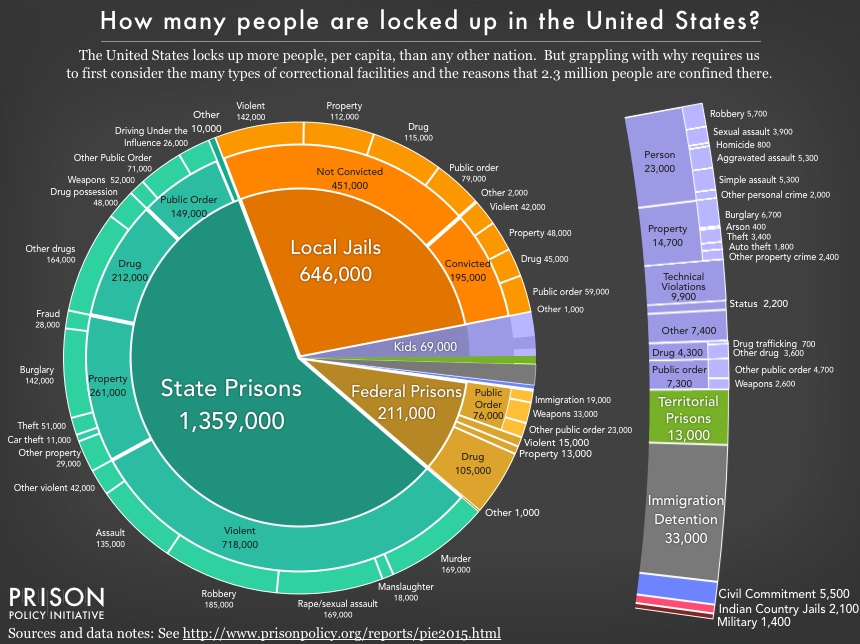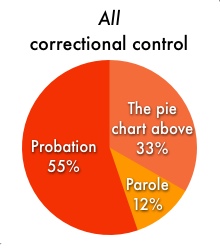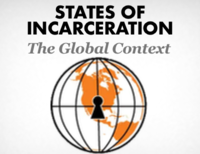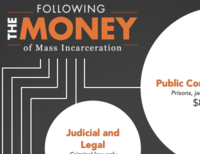Donate
Mass Incarceration: The Whole Pie 2015
By Peter Wagner and Bernadette Rabuy December 8, 2015
This report is old. See our new version.
Wait, does the United States have 1.4 million or more than 2 million people in prison? And do the 636,000 people released every year include the people getting out of local jails? Frustrating questions like these abound because our systems of federal, state, local, and other types of confinement — and the data collectors that keep track of them — are so fragmented. There is a lot of interesting and valuable research out there, but varying definitions and other incompatibilities make it hard — for both people new to criminal justice and for experienced policy wonks — to get the big picture.
This report offers some much needed clarity by piecing together this country’s disparate systems of confinement. The American criminal justice system holds more than 2.3 million people in 1,719 state prisons, 102 federal prisons, 2,259 juvenile correctional facilities, 3,283 local jails, and 79 Indian Country jails as well as in military prisons, immigration detention facilities, civil commitment centers, and prisons in the U.S. territories.1 And we go deeper to provide further detail on why people in the various systems of confinement are locked up.

While the numbers in each slice of this pie chart represent a snapshot of our correctional system, the graphic does not capture the enormous churn in and out of our correctional facilities and therefore the many more lives that are affected by the criminal justice system. In addition to the 636,000 people released from prisons each year, over 11 million people cycle through local jails each year. Jail churn is particularly high because at any given moment a majority of the people in local jails2 have not been convicted and are in jail because they are either too poor to afford bail and are being held pretrial,3 or because they have just been arrested and will make bail in the next few hours or days. The remainder of the people in jail — almost 200,000 — are serving time for minor offenses, generally misdemeanors with sentences under a year.
With a sense of the big picture, a natural follow-up question might be: how many people are locked up for a drug offense? While the data doesn’t give us a complete answer, we know that almost half a million adults and children are locked up because their most significant offense was a drug offense.4 The data confirms that nonviolent drug convictions are a defining characteristic of the federal prison system, but play only a supporting role at the state and local levels. Critically, while drugs are the most significant offense for only a minority of people in state and local facilities, there are 1.6 million drug arrests each year,5 giving residents of over-policed communities criminal records, which then serve to increase sentences imposed for any future offenses and have many other damaging effects.
All of this offense data comes with an important set of caveats. A person in prison for multiple offenses is reported only for the most serious offense6 so, for example, there are people in prison for “violent” offenses whose time in prison is extended by the fact that they were also convicted of a drug offense. Further, almost all convictions are the result of plea bargains, where people plead guilty to a lesser offense — an offense perhaps of a different category or one that they may not have actually committed. And many of these categories are nowhere near as clear as the labels imply. For example, “murder” is generally considered to be an extremely serious offense, but that broad category groups together the rare group of serial killers, with people who committed acts that are unlikely for reasons of circumstance or advanced age to ever happen again, with offenses that the average American would not consider to be murder at all. For example, the felony murder rule says that if someone dies during the commission of a felony, everyone involved is as guilty of murder as the person who pulled the trigger. Driving a getaway car during a bank robbery where someone was accidentally killed is indeed a serious offense, but few people would really consider that to be murder.7
This “whole pie” methodology also exposes some disturbing facts about the youth entrapped in our juvenile justice system: Too many are there for a “most serious offense” that is not even a crime. For example, there are almost 10,000 children behind bars for “technical violations” of the requirements of their probation or parole, rather than for a new offense. Further, more than 2,000 children are behind bars for “status” offenses, which are, as the U.S. Department of Justice explains: “behaviors that are not law violations for adults, such as running away, truancy, and incorrigibility.”
Turning finally to the people who are locked up because of immigration-related issues, we find that 19,000 people are in federal prison for criminal convictions of violating federal immigration laws. A separate 33,000 are civilly detained by U.S. Immigration and Customs Enforcement (ICE) separate from any criminal proceedings and are physically confined in special immigration detention facilities or in one of the many hundreds of local jails under contract with ICE. (Notably, these categories do not include the people represented in other pie slices who are also in some early stage of the deportation process because of non-immigration related criminal convictions.)
Now, armed with the big picture of how many people are locked up in the United States in the various types of facilities and for what offenses, we have a better foundation for the long overdue conversation about criminal justice reform. For example, the data makes it clear that ending the War on Drugs will not alone end mass incarceration, and it demonstrates why the policymakers and advocates who see ending the War on Drugs as a politically acceptable first step towards ending mass incarceration must take great care that their actions both constitute actual progress for people with drug offenses and do not make further reforms more difficult. Looking at the “whole pie” also opens up other conversations about where we should focus our energies:
- What is the role of the federal government in ending mass incarceration? The federal prison system is just a small slice of the total pie, but the federal government can certainly use its financial and ideological power to incentivize and illuminate better paths forward.
- Are state officials and prosecutors willing to rethink both the War on Drugs and the reflexive policies that have served to increase both the odds of incarceration and length of stay for “violent” offenses?
- Do policymakers and the public have the focus to also confront the geographically and politically dispersed second largest slice of the pie: the 3,283 local jails? Given that the people behind bars in this country are disproportionately poor and shut out of the economy8, does it make sense to lock up millions of people9 for a few days at a time for minor offenses? Will our leaders be brave enough to ask the public to support smarter investments in community-based drug treatment and job training? Or will they support the continued use of jails as mass incarceration’s front door?
 And once we have wrapped our minds around the “whole pie” of mass incarceration, we should zoom out and note that being locked up is just one piece of the larger pie of correctional control. There are another 850,000 people on parole (a type of conditional release from prison) and a staggering — and growing — 3.9 million people on probation (what is typically an alternative sentence). Particularly given the often onerous conditions of probation, policymakers should be cautious of “alternatives to incarceration” that serve to widen the net of punishment to people who previously would not have been subject to punishment in the first place.
And once we have wrapped our minds around the “whole pie” of mass incarceration, we should zoom out and note that being locked up is just one piece of the larger pie of correctional control. There are another 850,000 people on parole (a type of conditional release from prison) and a staggering — and growing — 3.9 million people on probation (what is typically an alternative sentence). Particularly given the often onerous conditions of probation, policymakers should be cautious of “alternatives to incarceration” that serve to widen the net of punishment to people who previously would not have been subject to punishment in the first place.
Now that we can see the big picture of how many people are locked up in the United States in the various types of facilities, we can see that something needs to change. Looking at the big picture requires us to ask if it really makes sense to lock up 2.3 million people on any given day, giving this nation the dubious distinction of having the highest incarceration rate in the world. Both policymakers and the public have the responsibility to carefully consider each individual slice in turn to ask whether legitimate social goals are served by putting each category behind bars, and whether any benefit really outweighs the social and fiscal costs.
We’re optimistic that this “whole pie” approach can give Americans, who are ready for a fresh look at the criminal justice system, some of the tools they need to demand meaningful changes to how we do justice.
Notes on the data
This briefing uses the most recent data available on the number of people in various types of facilities and the most significant charge or conviction. Because not all types of data are collected each year, we sometimes had to, for example, apply the percentage distribution of offense types from the previous year to the current year’s total count data. For this reason, we choose to round all figures in the graphic to the nearest thousand, except for children, civil commitment, Indian Country jails and military prisons, which were rounded to the nearest hundred. This process may also result in some parts not adding up precisely to the total.
We used the most recent data available as of September 22, 2015 from:
- Jails: Bureau of Justice Statistics, Jail Inmates at Midyear 2014 page 1 and Table 2, reporting total population and convicted status for June 30, 2014 and our analysis of the Survey Of Inmates In Local Jails, 200210 for offense types. See below and Who is in jail? Deep dive for why we used our own analysis rather than the otherwise excellent Bureau of Justice Statistics analysis of the same dataset, Profiles of Jail Inmates, 2002.
- Immigration detention: William Selway and Margaret Newkirk, “Congress Mandates Private Jail Beds for 34,000 Immigrants”, Bloomberg News, September 24, 2013.11
- Federal: Bureau of Justice Statistics, Prisoners in 2014, Table 1 and Table 12 reporting data as of September 30, 2014 (offense types) and December 31, 2014 (total population).
- State Prisons: Prisoners in 2014, Table 1 and Appendix Table 4 from data as of December 31, 2013 (offense types) and December 31, 2014 (total population).
- Military: Prisoners in 2014, Table 13 reporting data as of December 31, 2014.
- Territorial Prisons Correctional facilities in U.S. Territories (American Samoa, Guam, and the U.S. Virgin Islands) and U.S. Commonwealths (Northern Mariana Islands and Puerto Rico): Correctional Populations in the United States, 2013 Appendix Table 3, reporting data for December 31, 2013.
- Juveniles: Office of Juvenile Justice and Delinquency Prevention, Juveniles in Residential Placement, 2011, reporting data for October 26, 2011.
- Civil Commitment (At least 16 states and the federal government operate facilities for the purposes of detaining people convicted of sexual crimes after their sentences are complete. These facilities and the confinement there are technically civil, but in reality are quite like prisons. They are often run by state prison systems, are often located on prison grounds, and most importantly, the people confined there are not allowed to leave.): Deidre D’Orazio, Ph.D., Sex Offender Civil Commitment Programs Network Annual Survey of Sex Offender Civil Commitment Programs, 2014.
- Indian Country (correctional facilities operated by tribal authorities or the U.S. Department of the Interior’s Bureau of Indian Affairs): Bureau of Justice Statistics Correctional Populations in the United States, 2013 Appendix Table 3, reporting data for June 28, 2013.
- Probation and Parole: Our counts of the number of people on probation and parole are from Correctional Populations in the United States, 2013, Table 1 and Appendix Table 1, reporting data for December 31, 2013, and were adjusted to ensure that people with multiple statuses were counted only once in their most restrictive category.
Several data definitions and clarifications may be helpful to researchers reusing this data in new ways:
- To avoid anyone in immigration detention being counted twice, we removed the 16,384 people — cited in Table 8 of Jail Inmates at Midyear 2014 — confined in local jails under contract with ICE from the total jail population and from the numbers we calculated for those in local jails that are unconvicted.
- To avoid anyone in local jails on behalf of state or federal prison authorities from being counted twice, we removed the 81,738 people — cited in Table 9 of Prisoners in 2014 — confined in local jails on behalf of federal or state prison systems from the total jail population and from the numbers we calculated for those in local jails that are convicted.
- Because we removed ICE detainees and people under the jurisdiction of federal and state authorities from the jail population, we had to recalculate the offense distribution reported in Profile of Jail Inmates, 2002 who were “convicted” or “unconvicted” without the people who reported that they were being held on behalf of other agencies.12 Our definition of “convicted” was those who reported that they were “To serve a sentence in this jail,” “To await sentencing for an offense,” or “To await transfer to serve a sentence somewhere else”. Our definition of unconvicted was “To stand trial for an offense,” “To await arraignment,” or “To await a hearing for revocation of probation/parole or community release”.
Acknowledgements
This report was made possible by a generous grant from the Public Welfare Foundation and the contributions of individuals across the country who support justice reform. This project builds upon our previous work with a new analysis of the jail population and could not have been completed without the support of our intern Emily Widra and two members of our Young Professionals Network who were essential to unlocking the offense data for people in jails. Dan Kopf did some early processing of the data and spent many hours teaching us how to use the statistical package R, and Jo Balme wrote a python script that proved key to helping us refine our approach.
Footnotes
The number of state and federal facilities is from Census of State and Federal Correctional Facilities, 2005, the number of juvenile facilities from Census of Juveniles in Residential Placement, 2010, the number of jails from Census of Jail Facilities, 2006 and the number of Indian Country jails from Jails in Indian Country, 2014. We aren’t currently aware of a good source of data on the number of the facilities of the other types. ↩
The local jail population in the pie chart excludes the people being held in jails for other agencies so the population physically in jails (744,592) is larger than the population under jail jurisdiction reflected in the pie chart (646,478). See Table 1 of Jail Inmates at Midyear 2014. ↩
The unconvicted population is driving jail growth. Ninety-nine percent of jail growth in the last 15 years was in the detention of the legally innocent. ↩
The data doesn’t show how many people are convicted of drug law violations and are held in territorial prisons, Indian Country jails, or military facilities. ↩
In 2010, there were 1,638,850 drug arrests in the U.S., the far majority of which were for drug possession or use rather than for sale or manufacturing. See Table 1 Arrest in the United States, 1990-2010. ↩
The federal government defines the hierarchy of offenses with felonies higher than misdemeanors. And “[w]ithin these levels, ... the hierarchy from most to least serious is as follows: homicide, rape/other sexual assault, robbery, aggravated assault, burglary, larceny/ motor vehicle theft, fraud, drug trafficking, drug possession, weapons offense, driving under the influence, other public-order, and other.” See page 13 Recidivism of Prisoners Released in 1994. ↩
The felony murder rule has also been applied when the person who died was a participant in the crime. For example, if one of the bank robbers is killed by the police during a chase, the surviving bank robbers can be convicted of felony murder of their colleague. For example see People v. Hudson, 222 Ill. 2d 392 (Ill. 2006) and People v. Klebanowski, 221 Ill. 2d 538 (Ill. 2006) ↩
Our report on the pre-incarceration incomes of those imprisoned in state prisons, Prisons of Poverty: Uncovering the pre-incarceration incomes of the imprisoned, found that, in 2014 dollars, incarcerated people had a median annual income that is 41% less than non-incarcerated people of similar ages. Our preliminary analysis of jail data shows that people in jails may have even lower incomes. For pre-incarceration incomes of those in jails in 2002, see page 9 of Profile of Jail Inmates, 2002. ↩
Recall from above that more than 11 million people cycle through jail in a given year. ↩
This is the most recent data available until the Bureau of Justice Statistics begins administering the next Survey of Inmates in Local Jails in 2018. ↩
Notably, the number of people admitted to immigration detention in a year is much higher than the population detained on a particular day. The immigration detention system took in 440,600 people during the course of 2013. See page 1 of Immigration Detention: Additional Actions Needed to Strengthen Management and Oversight of Facility Costs and Standards. ↩
Responses to whether someone reported being held for an authority besides a local jail can be found in V113, or V115-V118 in the Survey of Inmates in Local Jails, 2002 Codebook.
↩



